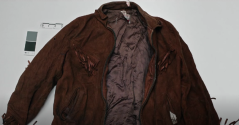Nice photos of the Starved Rock Inn.
Chester Weger, photographed in the Starved Rock Park cave during his re-enactment of the triple murder.
We can go on discussing this case forever. Here is my summary of the facts of the case and why I consider Chester Weger innocent of these crimes.
In 1960, a triple murder took place at Starved Rock State Park in Illinois. Chester Weger was ultimately convicted of these crimes, despite significant questions surrounding the case.
The murders involved three women, one of whom was Frances Murphy, wife of George Murphy. Frances's body showed signs of particularly brutal treatment compared to the other victims. She had been defecated on, urinated on, kicked in the groin, and had the tip of a finger cut off with a knife.
The investigation and subsequent trial were marked by several controversial elements.
There was no physical evidence connecting Weger to the crime scene.
Weger had only a one-hour lunch break on the day of the murders, yet the crime scene was over a mile away from his known location.
The lie detector tests in the case were conducted by Steven Kindig, who had personal connections to key figures involved. Kindig was a friend of George Murphy, the husband of one of the victims. Chester Weger was also given a lie detector test by Kindig. After successfully passing no less than six prior lie detector exams given by the Illinois State Police, Kindig said that Weger failed the test.
Glen and William Palmatier were implicated in the murders by a phone operator named Lois Zelensek, who claimed to have overheard a conversation between them about disposing of bloody clothes as well as the crime itself.
However, when Kindig administered lie detector tests, he found the Palmatier brothers truthful in their denials but deemed Zelensek's account untruthful. Interestingly, George Murphy was acquainted with Glen Palmatier, one of the men implicated in the overheard conversation.
It's crucial to understand the legal landscape of the time. During this era, prosecutors were not obligated to share exculpatory evidence with defense attorneys, as they are today. This means that any evidence potentially proving Weger's innocence might not have been made available to his defense team, significantly hampering their ability to mount an effective case.
Moreover, the right to an attorney and Miranda warnings, now considered fundamental to due process, were not yet established legal precedents. These rights were only mandated by Supreme Court decisions within a few years of the Weger case. This timing suggests that Weger's interrogation and initial legal proceedings might have lacked protections that are now considered essential for a fair trial.
The case took an intriguing turn in the aftermath of the murders. Less than a month before the crimes, a woman named Marion Anderson, possibly George Murphy's secretary, gave birth to a boy. The birth certificate did not list a father's name. Less than two years after his wife's murder, George Murphy married Marion Anderson and adopted her son, giving him the Murphy surname.
Upon their deaths, George Murphy chose to be buried next to his second wife, Marion, in a cemetery miles away from where his first wife of 29 years was laid to rest.
The timing of these personal events in George Murphy's life adds another layer of complexity to the case. The quick remarriage and adoption, coupled with the decision to be buried away from his first wife, raise questions about the nature of his relationship with Marion Anderson before the murders. It's worth noting that extramarital affairs were highly stigmatized in the 1960s, which could have provided a motive for covering up or misdirecting the investigation if there was any connection.
The inconsistencies in the case against Chester Weger are particularly troubling. The lack of physical evidence and the improbability of Weger committing the crimes within his limited time frame cast doubt on his conviction. Moreover, the connection between George Murphy, Steven Kindig, and Glen Palmatier suggests a potential conflict of interest in the investigation and polygraph examinations.
The differential treatment of the victims, with Frances Murphy receiving notably more brutal attention, could indicate a personal motive rather than a random act of violence. This detail, combined with George Murphy's subsequent life choices, opens up alternative theories about the true perpetrator and motive behind the murders.
The dismissal of Lois Zelensek's testimony about the Palmatier brothers is another point of contention. The decision to disregard her account based on a polygraph test administered by an examiner with personal connections to the case raises questions about the objectivity of the investigation.
These facts collectively paint a picture of a case that may have been prematurely closed, potentially allowing the real perpetrator(s) to escape justice.













